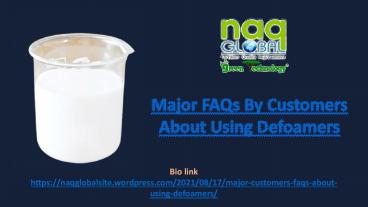FAQs About Using Defoamers By Customers (1) PowerPoint PPT Presentation
Title: FAQs About Using Defoamers By Customers (1)
1
Major FAQs By Customers About Using Defoamers
Bio link https//naqglobalsite.wordpress.com/2021/
08/17/major-customers-faqs-about-using-defoamers/
2
From oil-based defoamers to powder-based and
defoamer for phosphoric acid, meet the needs of a
diverse industrial field to control foam, improve
drainage and enhance performance. Unwanted foam
production can hinder performance and ensure foam
control to resolve the challenges of the
industry. From paper, wood pulp, paint,
industrial wastewater treatment, machine tools,
food processing, oils cutting tools, and
hydraulics, there unique formulated defoamer for
each industry challenge. Each defoamer is
characterized and designed according to technical
requirements, PH value, temperature, and other
factors. Above, we have assessed and tried to
answer some Frequently Asked questions we hope
it can help solve your queries.
3
1. How Does Defoamer Work?
The formation of foam in aqueous processes and
products can hinder or halt many industrial
processing operations. Defoamer or antifoams are
chemicals that hamper the formation of foam. The
anti-foaming agent penetrated in the constructed
foam bimolecular liquid film, causing the surface
tension of the liquid film to decrease. Defoamers
chemical suppliers combine antifoam, and
defoaming agents contain waxes, paraffin, or
silicas, disperse on foam, cause bubbles to
burst, and prevent foam build-up.
4
2. What is the difference between antifoam and
defoamer?
Antifoam and defoamers are interchangeable and
perform different functions. Anti-foaming agents
are added prior, ideally when at a stage just
beforehand, like before the addition of
surfactants which actively prevent foam build-up.
However, defoamers are added to liquids with the
foam already built up, and they break down the
foam to hinder tanks and containers from
overflowing.
5
3. Which I should prefer Defoamers or Antifoam
agents? Both are formulated to minimize or
eliminate foam formation. However, each is
designed to achieve desired goals in different
ways. Antifoams are surfactants that avoid the
appearance of foam in the first place, while
surfactants control existing foam levels by
stopping the bubbles from stabilizing.
6
3. Which I should prefer Defoamers or Antifoam
agents? Both are formulated to minimize or
eliminate foam formation. However, each is
designed to achieve desired goals in different
ways. Antifoams are surfactants that avoid the
appearance of foam in the first place, while
surfactants control existing foam levels by
stopping the bubbles from stabilizing.
7
- Defoamers and antifoam agents include
- Oil-based defoamers.
- Silicone-based defoamers.
- Phosphoric acid defoamers.
- Water-based defoamers.
- A variety of specialty formulated.
- A manufacturer of an aqueous product would
implement antifoam to a material to anticipate
potential problems associated. - Using the right defoamer or anti-foaming agent
would result in the desired effect on final
coating performance. The foam will be hindered,
and the appearance will be at its best.
8
4. How to select defoamers for coatings?
In the multitude coatings system, no one defoamer
is optimally suited for all formulations. There
is no suitable product that one-size-fits-all, a
range of defoamers chemical is required. Varying
dosages can finely adjust the effect. Various
factors and elements are considered when it comes
to selecting a defoamer for a specific
formulation.
9
We are defoamer chemical and filter aid powder
manufacturers, we understand the challenges
associated with each industry and provide an
extensive range of additives and coatings that
are high in performance.
10
5. How to choose the right defoamer, which is the
proper method to test? There are an array of
choices of defoamer chemicals, as per the type of
product, requirements, shell life, implementation
and duration, and much more. In addition, there
are two types of laboratory methods used the
temperature-controlled common standards release
fertilizer, and the other is the accelerated
method.
11
6. What are a few tips that I should follow to
use antifoam agents properly? Antifoams should
not be added in large amounts to prevent the
potential deposition into the panel. Avoid
alcohol-based antifoams though they are less
expensive, they could result in some side effects
and demand more additions in a shorter time. In
addition, some antifoams contain more significant
amounts of silicone, and deposited onto panels
can be challenging to remove, resulting in
plating issues.
12
NAQ Global is one fo the leading defoamer
chemical manufacturers in India. We have
extensive experience in defoamer, anti-foaming
agents, and fertilizer coating material for
different industries. With years of experience,
we have designed and developed unique solutions
to serve the needs of almost every
industry. Source link https//naqglobalsite.wordp
ress.com

